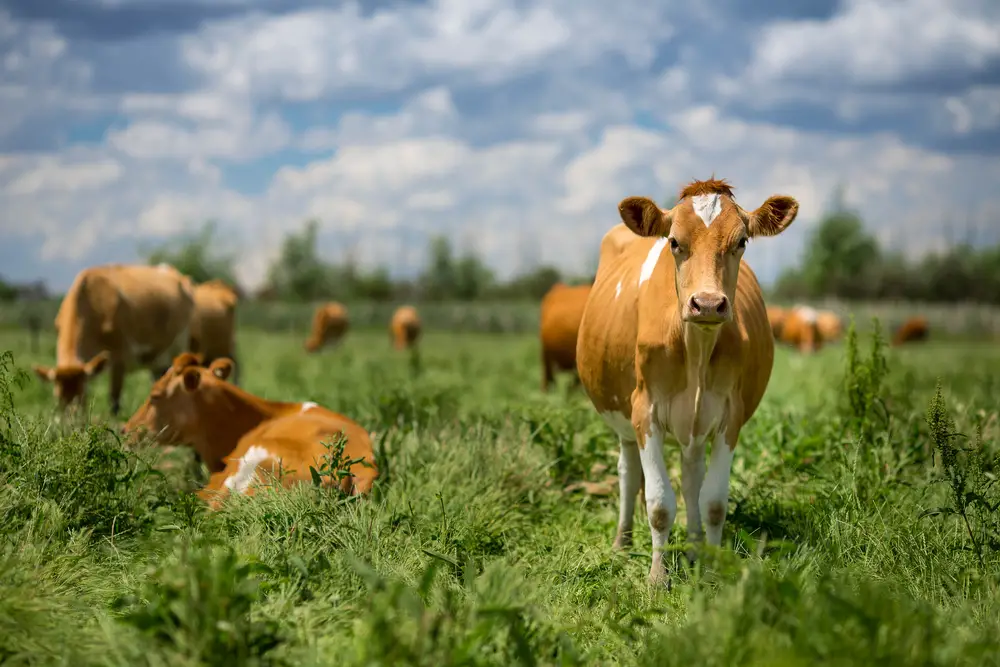Named for the Isle of Guernsey in the English Channel where they originated, Guernsey cattle are dairy cattle known for their golden-yellow milk. On average, a Guernsey cow produces 13,600 pounds of milk per lactation period
They are related to Jersey cows and are a breed known for their docile temperament, beauty and conformation, along with the quality of their milk.
Table of Contents
Where Does Guernsey Cattle Come From?
Guernsey cattle is one of three cattle breeds originally from the Channel islands along with Jersey and Alderney, the latter of which is extinct.
It is theorized that Guernsey cattle may be descended from mainland French cattle from Normandy, and possibly Froment du Leon cattle of Brittany that was brought over from France in the middle ages for draught purposes.
Some British and Dutch cattle were also introduced to the Channel Islands in the 1800s and they may have played a role in developing the Guernsey of today.
Importations of Guernsey cattle to England occurred in the 19th century, primarily to improve British dairy cattle.
Exports of Guernsey cattle were also economically important for the island of Guernsey and a substantial number of Guernsey cattle were later sold to buyers in North America in the 20th century.
Purebred Guernsey cattle played a large role as a foundational dairy breed in America for the dairy industry, and were used extensively through crossbreeding with other dairy breeds for improvement.
The American Livestock Breeds Conservancy placed the Guernsey on a watch list as annual registrations for this breed of dairy cattle are low, and there are currently less than 10,000 Guernsey cattle worldwide.
The primary reason for the decline is that the amount of milk produced is favored by commercial dairy farmers over quality, which has seen the Guernsey decline in popularity and use as it can’t compete with Holstein or Friesian cows.
Today, Guernsey cattle are primarily used in small farming operations and on homesteads.
Cattle Associations for Guernsey cattle include:
| United States | American Guernsey Association |
| Canada | Canada Gurnsey Association |
| United Kingdom | English Guernsey Cattle Society |
| Australia and NZ | Guernsey Cattle Society of Australia Guernsey NZ |
| Global | World Guernsey Cattle Federation |
Guernsey Cattle Breed Characteristics
| Official Breed Name | Guernsey Cattle |
| Scientific Name | Bos taurus taurus |
| Origin | Channel Islands |
| Appearance | Fawn-colored or red and white coat Have a somewhat blocky body with long, slender legs Feature brown, upturned snouts and mid-sized brown ears Have well-attached, forward-facing udders Both horned and polled varieties exist. |
| Calf Weight | 64lbs to 70lbs |
| Mature Cow Weight | Approximately 1400lbs |
| Mature Bull Weight | Approximately 2000lbs |
| Ready To Breed | 13 to 15 months |
| Gestation Period | 283 days |
| First Calvings | 22 months |
| Time to Slaughter | 12 months |
| Expected Lifespan | 10-15 years |
| Known For | Dairy breed producing high quality milk Calm disposition with maternal aptitude Climate adaptability and efficient foraging |
| Weaknesses | Produces less milk than other commercial dairy breeds Bulls have an aggressive temperament |
| Climate | Does well in cold and warm climates |

What Is So Special About Guernsey Cattle?
Guernsey cows are dairy cows that produce rich milk that has a golden color due to beta-carotene, which when processed by the body, converts to vitamin A. Their milk a high butterfat percentage (5%) and is likewise high in protein (3.7%).
Guernsey milk has a trademark for advertising purposes and it is promoted as “Golden Guernsey”. The color of Guernsey milk also translates into butter made from the milk, giving it a golden sheen.
The Guernsey breed produces 13,600 pounds of milk per lactation period.
In comparing Guernsey milk with average milk on the market, Guernsey milk has higher protein (12% more), more cream (up to 30% more), higher vitamin D (33% more), more vitamin A (25% more), and higher calcium (15% more)!
Why Should I Raise Guernsey Cattle On My Farm?
- Feed efficient breed, consuming 20 to 30 percent less feed to produce a pound of milk
- No known recessive genetic traits causing negative effects
- Lower calving interval than other dairy breeds
- Heifers have a younger average age of producing their first calf at 22 months, increasing profitability
- Early maturation and fewer birthing complications
- Calves are vigorous and ready to suckle immediately
- Adaptable to different types of management systems
- Pricing for Guernsey cows ranges from $900 to $3000
